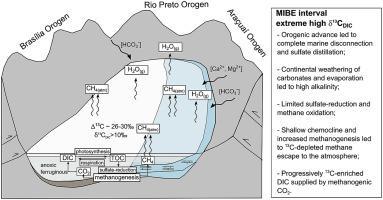Geoscience Frontiers ( IF 8.5 ) Pub Date : 2020-04-21 , DOI: 10.1016/j.gsf.2020.04.005 Sergio Caetano-Filho , Pierre Sansjofre , Magali Ader , Gustavo M. Paula-Santos , Cristian Guacaneme , Marly Babinski , Carolina Bedoya-Rueda , Matheus Kuchenbecker , Humberto L.S. Reis , Ricardo I.F. Trindade

|
Carbon isotope compositions of both sedimentary carbonate and organic matter can be used as key proxies of the global carbon cycle and of its evolution through time, as long as they are acquired from waters where the dissolved inorganic carbon (DIC) is in isotope equilibrium with the atmospheric CO2. However, in shallow water platforms and epeiric settings, the influence of local to regional parameters on carbon cycling may lead to DIC isotope variations unrelated to the global carbon cycle. This may be especially true for the terminal Neoproterozoic, when Gondwana assembly isolated waters masses from the global ocean, and extreme positive and negative carbon isotope excursions are recorded, potentially decoupled from global signals. To improve our understanding on the type of information recorded by these excursions, we investigate the paired δ13Ccarb and δ13Corg evolution for an increasingly restricted late Ediacaran-Cambrian foreland system in the West Gondwana interior: the basal Bambuí Group. This succession represents a 1st-order sedimentary sequence and records two major δ13Ccarb excursions in its two lowermost lower-rank sequences. The basal cap carbonate interval at the base of the first sequence, deposited when the basin was connected to the ocean, hosts antithetical negative and positive excursions for δ13Ccarb and δ13Corg, respectively, resulting in Δ13C values lower than 25‰. From the top of the basal sequence upwards, an extremely positive δ13Ccarb excursion is coupled to δ13Corg, reaching values of +14‰ and −14‰, respectively. This positive excursion represents a remarkable basin-wide carbon isotope feature of the Bambuí Group that occurs with only minor changes in Δ13C values, suggesting change in the DIC isotope composition. We argue that this regional isotopic excursion is related to a disconnection between the intrabasinal and the global carbon cycles. This extreme carbon isotope excursion may have been a product of a disequilibria between the basin DIC and atmospheric CO2 induced by an active methanogenesis, favored by the basin restriction. The drawdown of sulfate reservoir by microbial sulfate reduction in a poorly ventilated and dominantly anoxic basin would have triggered methanogenesis and ultimately methane escape to the atmosphere, resulting in a 13C-enriched DIC influenced by methanogenic CO2. Isolated basins in the interior of the Gondwana supercontinent may have represented a significant source of methane inputs to the atmosphere, potentially affecting both the global carbon cycle and the climate.
中文翻译:

冈瓦纳超大陆核心地带的大型产甲烷甲烷化班贝海?
沉积碳酸盐和有机物的碳同位素组成都可以用作全球碳循环及其随时间演变的关键代理,只要它们是从溶解的无机碳(DIC)与同位素处于平衡状态的水中获取的。大气CO 2。但是,在浅水平台和大风环境中,局部参数到区域参数对碳循环的影响可能导致DIC同位素变化与全球碳循环无关。当冈瓦纳人大会从全球海洋中隔离水域,并且记录到极端正负碳同位素偏移,并有可能与整体信号脱钩时,对于新元古代末期尤其如此。为了提高我们对这些游览记录的信息类型的理解,我们研究了配对δ 13 C ^碳水化合物和δ 13 C ^组织冈瓦纳西部内陆地区受限制的晚期Ediacaran-Cambrian前陆系统的演化:基底Bambuí组。这个连续表示1第一阶沉积序列并记录两个主要δ 13 Ç碳水化合物在其两个最下面下级序列偏移。在第一序列的基础上,当所述盆连接于海洋沉积基底帽碳酸盐间隔,主机对立负和正偏移为δ 13 C ^碳水化合物和δ 13 Ç有机分别导致Δ 13C值低于25‰。从基序列的顶部向上,一个非常积极的δ 13 C ^碳水化合物偏移耦合到δ 13 Ç组织,分别达到的+ 14‰和-14‰值。此正偏移表示Bambuí组,随着Δ只有轻微的变化发生显着的全流域碳同位素特征13 C值,这表明在DIC同位素组成的变化。我们认为,这种区域同位素偏移与基底内碳循环和全球碳循环之间的脱节有关。这种极端的碳同位素漂移可能是盆地DIC和大气CO 2之间不平衡的产物由主动产甲烷作用诱导,受盆地限制有利。在通风不良且占主导地位的缺氧盆地中,通过微生物硫酸盐还原作用而减少的硫酸盐储集层将触发甲烷化作用,最终甲烷逸散到大气中,从而导致13 C富集的DIC受甲烷化CO 2的影响。冈瓦纳超大陆内部孤立的盆地可能是甲烷向大气中输入的重要来源,可能会影响全球碳循环和气候。









































 京公网安备 11010802027423号
京公网安备 11010802027423号